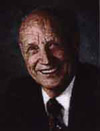Richard S. Culton
5th Air Force (5th AF), 35th Fighter Group (35th FG),
41st Fighter Squadron (41st FS)
P-39 Airacobra pilot
in New Guinea
Background
Richard S. Culton was born in 1919 in Kentucky. In 1941, he lived in Bexar County in Texas. He attended four years of college before he enlisted in the U.S. Army Air Force (USAAF) as an aviation cadet with serial number 18057083.
Enlisting in the Army
 On September 27, 1941 I enlisted in the Army at Fort Sam Houston, San Antonia, Texas. I
was enlisted for three days when orders came through to report to
Primary Flying School at Visalia, California. During my third week
the Japanese attacked Pearl Harbor. After completion of primary
I was transferred to Lamore Air Corps Basic flight training (I was
in the first Class that was trained there) and upon completion was
transferred to Luke Field, Phoenix, Arizona (graduated in Class
42-D). Then I was transferred to Myrtle Beach for gunnery training
(in P-40F Warhawks) days then transferred to Morris Field, Charlotte, NC.
While there I plowed potatoes with a P-40 because it had been sabotaged
by having acid applied to the carburetor heat control and my flight
plan had me too far from the landing strip when the heat control
came on full hot. On September 27, 1941 I enlisted in the Army at Fort Sam Houston, San Antonia, Texas. I
was enlisted for three days when orders came through to report to
Primary Flying School at Visalia, California. During my third week
the Japanese attacked Pearl Harbor. After completion of primary
I was transferred to Lamore Air Corps Basic flight training (I was
in the first Class that was trained there) and upon completion was
transferred to Luke Field, Phoenix, Arizona (graduated in Class
42-D). Then I was transferred to Myrtle Beach for gunnery training
(in P-40F Warhawks) days then transferred to Morris Field, Charlotte, NC.
While there I plowed potatoes with a P-40 because it had been sabotaged
by having acid applied to the carburetor heat control and my flight
plan had me too far from the landing strip when the heat control
came on full hot.
41st Fighter Squadron
 HQ Army Air Base, Morris Field, Charlotte NC, 20 Aug 1942, Special
Orders #229 Par 1 ordered to Hamilton Field. I was
put on board a B-24 to Hickam Field, hence to Christmas
Island, New Caledonia, then Brisbane, transferred planes then to
Townsville, stayed three day by a PBY aircraft then landed in the bay at
Port Moresby then by 2 ½ ton GMC truck to 7 Mile
Drome. This was the 5th Air Force (5th AF), 35th
Fighter Group (35th FG), 41st Fighter Squadron (41st FS), using yellow nose P-39 Airacobra as our aircraft. All my training had been in aircraft which had
tail wheel. Crew chief explained that P-39 took off at 110 instead of 78
and it stalled at 97 instead of 62 and I should fly it all the way in,
not stall it in. HQ Army Air Base, Morris Field, Charlotte NC, 20 Aug 1942, Special
Orders #229 Par 1 ordered to Hamilton Field. I was
put on board a B-24 to Hickam Field, hence to Christmas
Island, New Caledonia, then Brisbane, transferred planes then to
Townsville, stayed three day by a PBY aircraft then landed in the bay at
Port Moresby then by 2 ½ ton GMC truck to 7 Mile
Drome. This was the 5th Air Force (5th AF), 35th
Fighter Group (35th FG), 41st Fighter Squadron (41st FS), using yellow nose P-39 Airacobra as our aircraft. All my training had been in aircraft which had
tail wheel. Crew chief explained that P-39 took off at 110 instead of 78
and it stalled at 97 instead of 62 and I should fly it all the way in,
not stall it in.
April 12 1943 Mission Over Port Moresby
The April 12, 1943 interception was my 70th combat mission. As I
remember we only had 15 aircraft take off that day, including 3 P-38,
7 P-39, 2 B-25 and 1 B-26 to attack the Japanese aircraft. I never
did find out how many they had, also I never found out of any other
of our aircraft than those I have listed. I was shot down in P-39D
41-38351. When I got into the hospital much of what happened got
very blurry. I spent 1,004 days in 18 different hospitals before finally
being returned to general military duty on flying status.
References
NARA World War II Army Enlistment Records - Richard S. Culton
|

